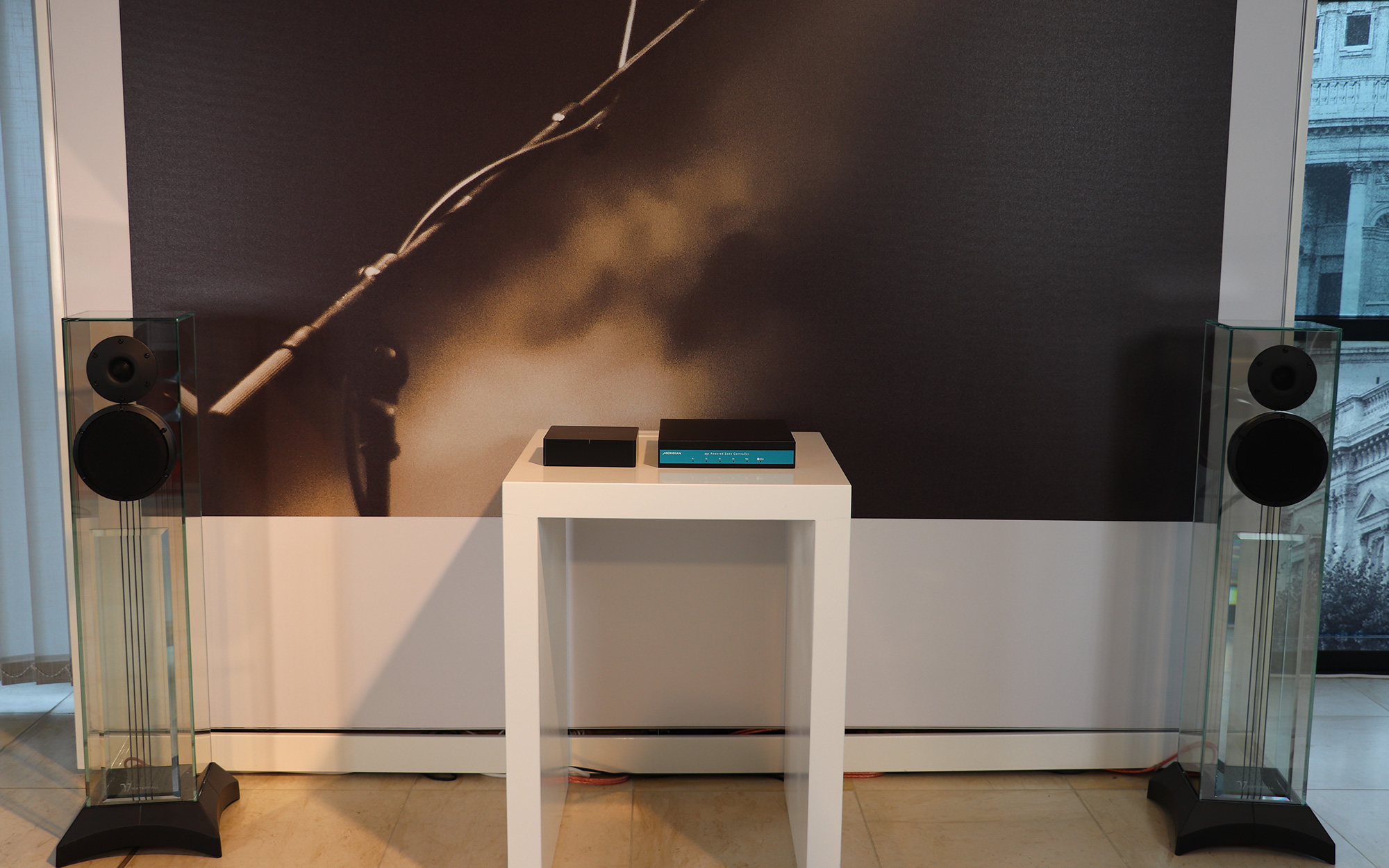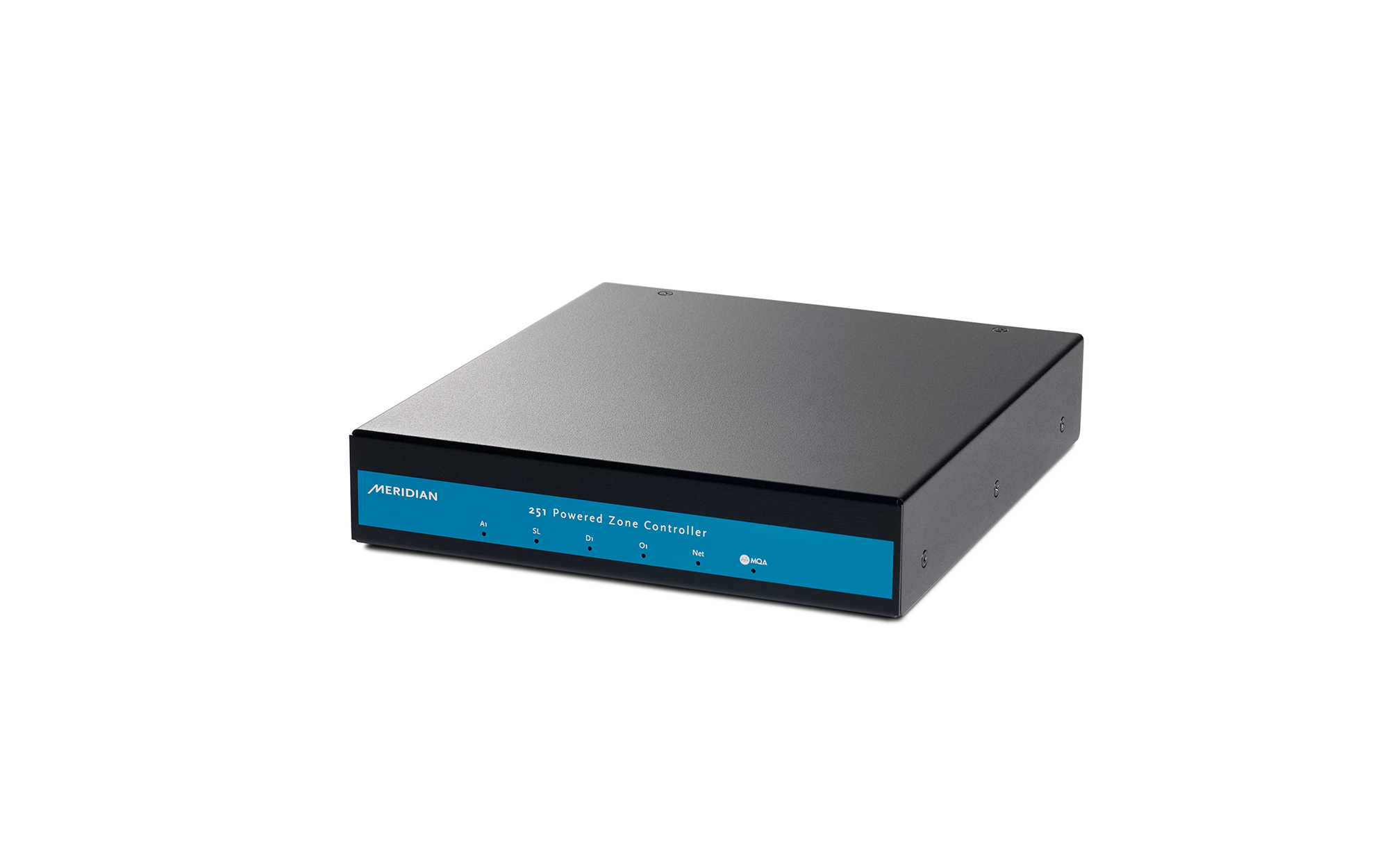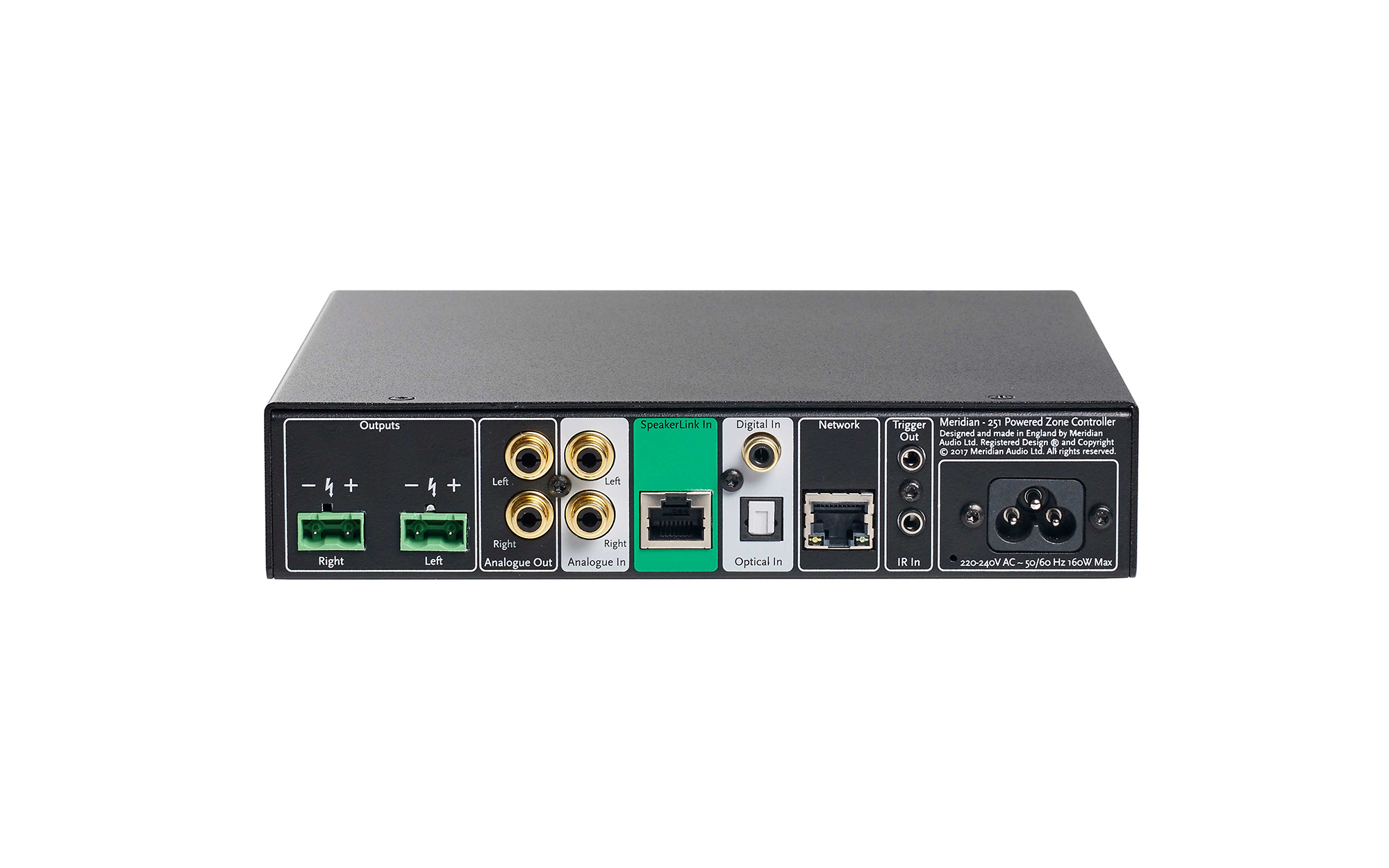
Zone Control
Meridian customers - create an account so you can register your product(s) for your extended warranty.
Dealers, integrators, and installers - create an account to request access to Dealer Resources and/or apply to become a Meridian dealer.

Zone Control
Designed for in-room and in-rack systems, the 251 Powered Zone Controller contains all the functionality needed to create
a great sounding and flexible Hi-Res Audio zone.
With two powerful, cool-running channels of on-board amplification, the Meridian 251 can comfortably drive a pair of loudspeakers or a sound bar with our trademark fidelity and High Resolution performance.
Zone Control
251
Designed for use in-room or in-rack, the 251 Powered Zone Controller contains the functionality needed to create a powered Hi-Res audio zone. The Meridian 251 features two powerful, high performance, cool-running 100W Class D Amplifiers that allow this versatile 1U tall product to be easily partnered with any passive loudspeaker. Accommodating both local and distributed audio, whether analogue or digital, the MQA-enabled Meridian 251 is also an endpoint for Roon. Control features including IP and IR allow this versatile solution to be seamlessly integrated into the home.
Meridian Q-Sync deploys Meridian's multiple “First In, First Out” buffering system which minimises jitter, ensuring perfect timing and improved clarity.
Meridian True Link is an encryption method for transferring high-definition digital audio over SPDIF connections. It allows secure movement of digital audio whilst ensuring that the SPDIF clock signal can be transmitted with minimum degradation.
True Time is Meridian's proprietary Apodising Filter that avoids pre-ringing and cleans up the effects of early filters, converting pre-echo to post-echo.

Meridian Digital Precision maximises the signal-to-noise ratio of the digital audio, ensuring the finest details of every song are retained.
Roon Tested devices are profiled by the Roon team to ensure simple setup and effortless daily use.
Seamlessly stream music from the Sonos app to a Meridian system and control the music from anywhere around the home using the Sonos interface. Works in conjunction with the Sonos Port or Sonos Connect products.
Supports full unfold of MQA files to feed its analogue outputs or performs first unfold to feed an MQA renderer product digitally.
The Meridian 200 Series is a collection of high-performance audio zone controllers, theatre controllers and amplifiers, all designed with the Customer Integrator in mind.
Each product is designed to work in isolation or as part of a larger multi-zone audio-visual installation and a compact footprint means they fit perfectly within the rack. With a wide range of audio inputs and outputs, flexible installation options and many of Meridian’s proprietary technologies on board, 200 Series products deliver outstanding performance in many applications.
Here you will find a quick overview of the product highlights and features.
Here you will find a summary of the complete range of Meridian products in one document.
AUDIO INPUTS
One 2-channel digital coaxial S/PDIF input. 44.1kHz to 192kHz sampling and up to 24-bit
One 2-channel Meridian SpeakerLink input. 44.1kHz to 192kHz sampling and up to 24-bit
One 2-channel digital optical TOSLINK input. 44.1kHz to 96kHz sampling and up to 24-bit
One 2-channel analogue input on RCA phono connectors
One network input (Ethernet) for connection to a Roon system or an alternative control interface
AUDIO OUTPUTS
Speaker outputs on Phoenix connectors
24-12 AWG Compatible
2 x 100w into 4Ω nominal load (2 x 65w into 8Ω)
40kHz Bandwidth
2-channel line-level analogue output on RCA phono connectors
Twin 192kHz 24-bit DACs
DISPLAY
LEDs to indicate source selection and MQA status
DIMENSIONS
HEIGHT: 42mm [1.65in] (without feet)
WIDTH: 204mm [8.03in]
DEPTH: 221mm [8.7in] (226mm inc. connectors) [8.89in]
WEIGHT: Standalone: 2.5Kg [5.5lbs]
POWER
Advanced linear power supply: 110–120V ac 50–60Hz | 220-240V ac 50-60Hz
RACK-MOUNTING
1U tall rack kit available with space for two units
Optional VESA mount brackets
CONTROL SIGNALS
IP Control
IR on 3.5mm jack
Meridian Comms




The 251 is intended to be partnered with a pair of passive loudspeakers to provide audio in a single room or zone. It can be controlled over IP via the product’s Ethernet network socket, from an IR receiver plugged into the unit or via Meridian comms from suitably-equipped Meridian products. The 251 carries analogue and digital inputs and features high-performance amplification. In addition to its two speaker outputs, the 251 carries a pair of line-level analogue outputs so it can run a 2.1 system with a subwoofer or be used with additional external amplification. The 251 also acts as a Roon audio end-point and it supports the decoding of MQA files.
Yes. It has inputs which accept conventional line-level analogue audio and industry-standard SPDIF digital audio – in both co-axial and optical forms. Its speaker outputs can be used with any conventional passive loudspeakers. The line-level outputs are suitable for use with powered subwoofers, any standard power amplification or analogue active loudspeakers.
Once some form of control is added, the 251 can act as a conventional integrated amplifier providing source selection, volume control and power amplification.
The amplification is cool-running and provides up to 2 x 100W per channel into 4 Ohms (2 x 65W per channel into 8 Ohms). The amplification has a high peak output current capability to drive difficult loads and offers a true Hi-Res bandwidth of 40 kHz.
The potential for high-power output from the 251 means that only loudspeakers with suitably high power handling figures should be used with the 251. Lower rated loudspeakers could be bottomed out when the volume is turned up high.
In addition, when selecting loudspeakers for use with the 251, it is advised that the impedance curve for the loudspeaker is checked. The single figure given as the 'nominal impedance' for a loudspeaker can mask the fact that the actual impedance may be considerably lower at some frequencies. At these frequencies, the loudspeaker will demand more current, and if the power required exceeds the capabilities of the 251, the protection system of the product will shut down the amplifier section causing the loudspeakers to fall silent.
It is strongly recommended that only one loudspeaker is used on each of the 251’s outputs.
If more than one loudspeaker is connected in parallel on one output, the impedance of the load presented to the amplifier is reduced and this increases the current demand. As an example, two 6 Ohm loudspeakers in parallel present a load of 3 Ohms, which doubles the current required from the amplifier. If too much current is demanded from the 251, it will protect itself and the loudspeakers will fall silent
If more than one loudspeaker is connected in series on one output, the current demand is not increased, but there is potential for a different problem. If the loudspeakers are not identical, or if they are not in exactly the same acoustic environment, sound quality can suffer due to their relationship with the dampling factor of the amplifier. The term 'not in exactly the same acoustic environment' is particularly relevant to in-wall and in-ceiling loudspeakers as, even when they are identical, their 'enclosures' (i.e. the wall or ceiling voids they are installed in) are very likely to differ.
192kHz, 24 bit.
96kHz, 24 bit.
There is no practicable limit as long as the network is capable of dealing with the traffic derived from multiple devices.
The 251 can be updated using the latest version of the Meridian Device Manager program for PC. Simply run the program on a computer connected to the same network as the 251 and the option to update the firmware will be offered if a newer version is available. This update method also applies to systems with multiple 251s on the network.
The unit features a high-quality linear PSU and is powered via a “clover-leaf” mains lead (supplied with the product).
This socket is intended to allow the connection of an infra-red receiving device, such as the Meridian G12 Remote Sensor.
One possible explanation is that the 251 needs to have its IR reception enabled. This can be done via the 251 configuration web-page. Set 'IR mode' to 'Controller' and store the settings to the product. Note: if 'IR mode' is set to 'Auto', infer-red reception will be enabled only after the unit has received a 'Clear' command from the remote control via its IR receiver.
Yes. Many third-party control systems feature outputs suitable for feeding IR emitter devices (also referred to as IR 'blasters'). The signals from these outputs differ from the signals derived from infra–red receivers in that they are modulated with a carrier frequency. However, the 251 is designed to receive both types of signal without any issues.
Some equipment introduces delay to video signals fed through it. Processes such as scaling can cause this. Lip Sync allows a delay of up to 85 milliseconds to be added to the audio signal to correctly align the sound and picture. However, if the converse is happening and audio is delayed relative to video, i.e. sound is behind the pictures, LipSync cannot be used to rectify the problem.
Unwanted delays can be problematic in multi-zone systems which include a mixture of one of more zones using FFA-capable Meridian DSP loudspeakers and one or more zones using analogue loudspeakers. This stems from the fact that FFA introduces a delay to audio through the Meridian loudspeakers. In such systems, if two of the differing types of zone are linked so that they play material simultaneously, the delay on the Meridian loudspeakers may be noticeable if the listener is positioned where they are able to hear sound from more than one zone type. Having the analogue-speaker zones fed by 251s allows LipSync to be used to add delay to align the sound in these zones to the sound from the Meridian loudspeaker zones.
The trigger can be configured to go high (12V) or low (0V) on a source-by-source basis. The socket accepts a mono 3.5 mm jack plug with the tip as the positive connection and screen as ground.
There are several methods for controlling the 251. It can be controlled via its network connection. The Meridian Control app (available from the Apple App Store and Google Play Store) provides access to all relevant functions. Third-party control-systems can control the product via its Automation Protocol. The 251 can also be controlled via infra-red if used in conjunction with an infra-red receiver device such as the Meridian G12. When used in combination with certain Meridian products, the 251 can be controlled via the Meridian 'comms' system.
Although the 251 has only one pair of line-level analogue output sockets, the output is capable of driving the inputs of more than one power amplifier in parallel - providing the amplifiers have conventional high-impedance inputs. For example, all eight channels on the Meridian 258 multi-channel amplifier can be fed from one 251 to provide sound for four pairs of speakers.
They are often referred to as ‘Phoenix’-style connectors. The connector was chosen because it is widely available from online suppliers around the world. This type of connector comes in various sizes, so it is important to order to correct version. The one supplied with the product is designated Wurth 691351400002. It can be sourced from most suppliers of electrical and electronic components.